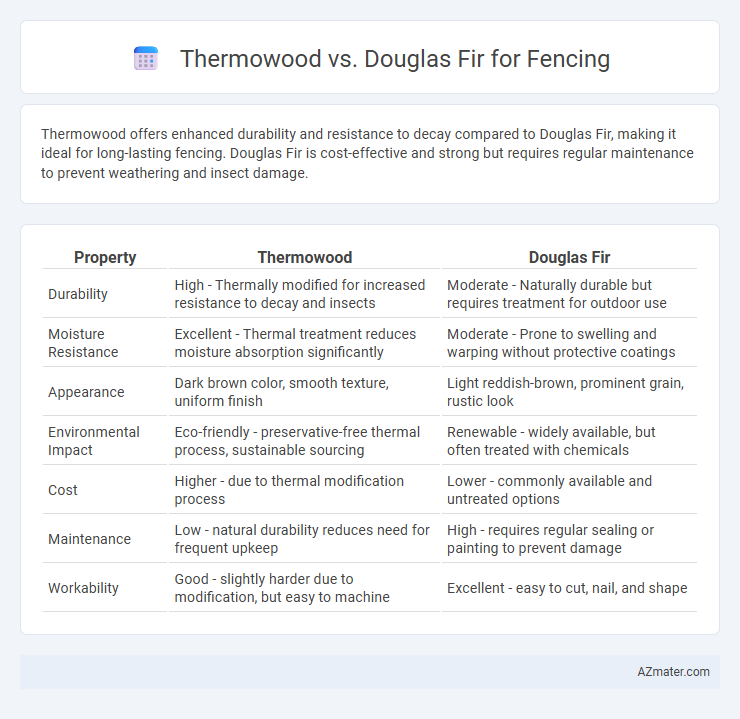Thermowood offers enhanced durability and resistance to decay compared to Douglas Fir, making it ideal for long-lasting fencing. Douglas Fir is cost-effective and strong but requires regular maintenance to prevent weathering and insect damage.
Table of Comparison
| Property | Thermowood | Douglas Fir |
|---|---|---|
| Durability | High - Thermally modified for increased resistance to decay and insects | Moderate - Naturally durable but requires treatment for outdoor use |
| Moisture Resistance | Excellent - Thermal treatment reduces moisture absorption significantly | Moderate - Prone to swelling and warping without protective coatings |
| Appearance | Dark brown color, smooth texture, uniform finish | Light reddish-brown, prominent grain, rustic look |
| Environmental Impact | Eco-friendly - preservative-free thermal process, sustainable sourcing | Renewable - widely available, but often treated with chemicals |
| Cost | Higher - due to thermal modification process | Lower - commonly available and untreated options |
| Maintenance | Low - natural durability reduces need for frequent upkeep | High - requires regular sealing or painting to prevent damage |
| Workability | Good - slightly harder due to modification, but easy to machine | Excellent - easy to cut, nail, and shape |
Introduction to Thermowood and Douglas Fir
Thermowood is a sustainably treated softwood enhanced through high-temperature steam treatment, increasing its durability, stability, and resistance to decay without chemicals. Douglas Fir is a dense, strong softwood known for its structural integrity, natural resistance to rot, and attractive reddish-brown grain, commonly used in outdoor fencing. Comparing Thermowood and Douglas Fir involves evaluating their longevity, maintenance needs, and environmental impact in fencing applications.
Overview of Thermowood Properties
Thermowood is a heat-treated timber known for enhanced durability, dimensional stability, and resistance to decay and insects, making it highly suitable for outdoor applications like fencing. The thermal modification process reduces wood moisture content and increases resistance to weathering without the need for chemical preservatives. These properties give Thermowood an advantage over untreated Douglas Fir, providing longer lifespan and lower maintenance for fences exposed to harsh environmental conditions.
Key Characteristics of Douglas Fir
Douglas Fir is known for its strength, durability, and affordability, making it a popular choice for fencing. Its natural resistance to decay and insect damage ensures a long-lasting fence, while its fine, straight grain provides an attractive finish. Compared to Thermowood, Douglas Fir requires regular maintenance to preserve its appearance and structural integrity.
Durability Comparison: Thermowood vs Douglas Fir
Thermowood offers superior durability for fencing due to its heat-treated process, which enhances resistance to decay, fungi, and insect attacks compared to untreated Douglas Fir. Douglas Fir is naturally strong but more susceptible to environmental damage without protective treatments or coatings. The thermal modification in Thermowood significantly extends the lifespan of fences, making it more suitable for harsh weather conditions than standard Douglas Fir.
Weather Resistance and Longevity
Thermowood offers superior weather resistance due to its heat-treated process, which significantly reduces moisture absorption and enhances durability against rot and insect damage, making it ideal for long-lasting fences. Douglas Fir, while naturally strong and moderately resistant to decay, requires regular maintenance and treatment to withstand harsh weather conditions over time. For maximum longevity and minimal upkeep in outdoor fencing, Thermowood provides a more reliable solution compared to untreated or lightly treated Douglas Fir.
Aesthetic Differences: Color and Grain
Thermowood offers a rich, dark brown hue with a uniform appearance due to its thermal modification process, enhancing its natural grain with a smooth, matte finish ideal for modern fence designs. Douglas Fir displays a warm, reddish-yellow tone with prominent, varied grain patterns that add a rustic, natural charm to outdoor structures. The choice between Thermowood and Douglas Fir hinges on desired visual impact: Thermowood provides consistent, contemporary aesthetics, while Douglas Fir delivers classic, textured beauty.
Environmental Impact and Sustainability
Thermowood undergoes a heat treatment process that enhances durability without chemical preservatives, significantly reducing its environmental impact compared to untreated wood like Douglas Fir. Douglas Fir, while renewable and fast-growing, often requires chemical treatments for outdoor use, leading to potential soil and water contamination. Choosing Thermowood supports sustainability by extending the lifespan of fence materials with minimal ecological footprint and promoting responsible forestry practices.
Maintenance Requirements for Each Material
Thermowood requires minimal maintenance due to its enhanced durability and resistance to decay, needing only occasional cleaning and sealing every few years to maintain its appearance and performance. Douglas Fir demands more frequent upkeep, including annual staining or sealing to protect against moisture, UV damage, and insect infestation, which can otherwise lead to warping and rot. Choosing Thermowood reduces long-term maintenance costs and effort, making it ideal for low-maintenance fencing solutions.
Cost Analysis: Thermowood vs Douglas Fir
Thermowood fencing costs typically range from $15 to $25 per linear foot, reflecting its enhanced durability and low maintenance requirements compared to Douglas Fir, which averages $10 to $18 per linear foot but demands more frequent treatments to resist decay. While Thermowood's upfront price is higher, reduced long-term maintenance expenses and extended lifespan often result in lower total cost of ownership over 15-20 years. Douglas Fir offers initial savings but incurs increased costs from regular sealing, staining, or replacements due to its vulnerability to moisture and insect damage.
Which is Best for Your Fence?
Thermowood offers superior durability and resistance to rot and insects due to its heat treatment process, making it an excellent choice for long-lasting fences in various climates. Douglas Fir is valued for its strength and natural beauty but requires regular maintenance to protect against moisture and decay. For a low-maintenance, stable fence, Thermowood is best; for a budget-friendly option with classic aesthetics and regular upkeep, Douglas Fir remains a solid choice.

Infographic: Thermowood vs Douglas Fir for Fence
 azmater.com
azmater.com